Abstract
We have analyzed the specificity and function of natural killer (NK) cells in mice with a homozygous deletion of the major histocompatibility complex (MHC)-encoded transporter gene associated with MHC class I-restricted antigen presentation (Tap-1). These mice express very low levels of class I molecules at the cell surface, and these molecules are either devoid of peptide or occupied only by TAP-independent peptides. NK cells in Tap-1 -/- mice, through normal in number, appeared tolerant toward autologous Tap-1 -/- Con A-activated blasts, Tap-1 -/- as well as allogeneic BALB/c bone marrow cells, and RMA-S tumor cell grafts. In contrast, they killed YAC-1 cells as efficiently as did NK cells from wild-type mice. Defective Tap-1 expression was sufficient to render nontransformed target cells sensitive to NK cell-mediated lysis. It is concluded that proper expression of TAP molecules is necessary for normal development of NK cells, as well as for rendering target cells resistant to NK cell-mediated lysis. These results support the hypothesis that class I molecules of the MHC influence the sensitivity of target cells to lysis by NK cells, as well as the development of the NK cell repertoire.
Full text
PDF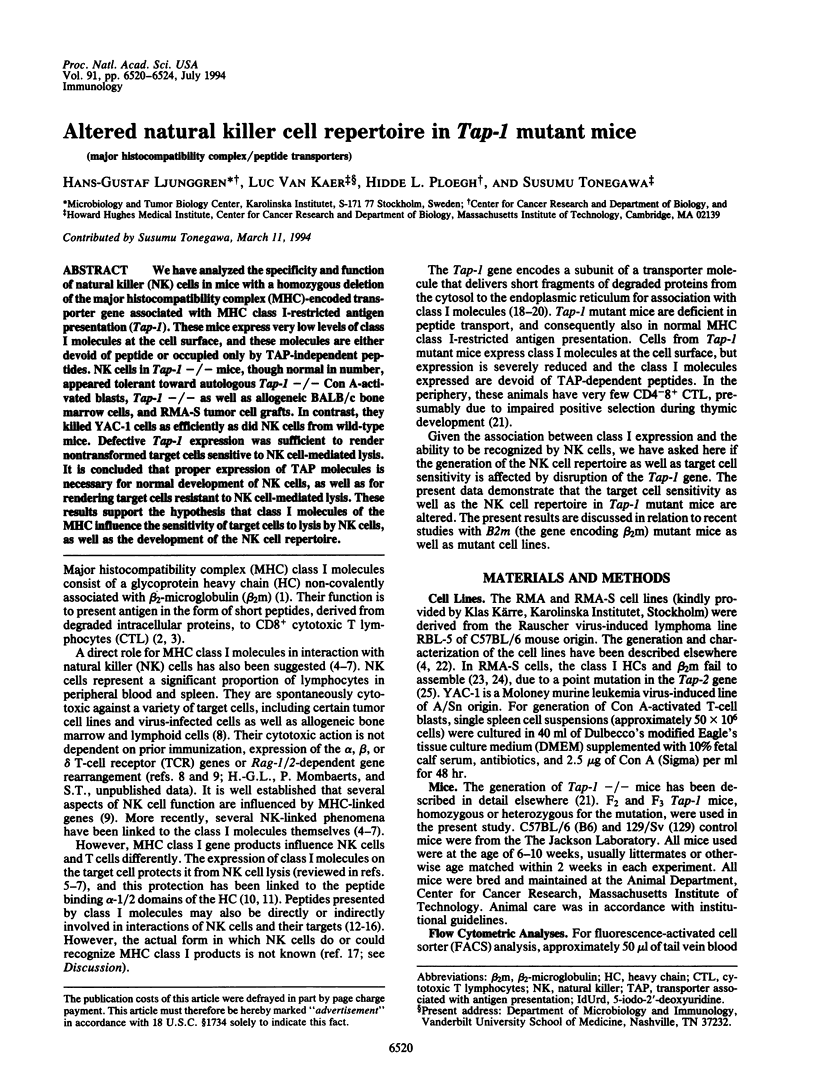
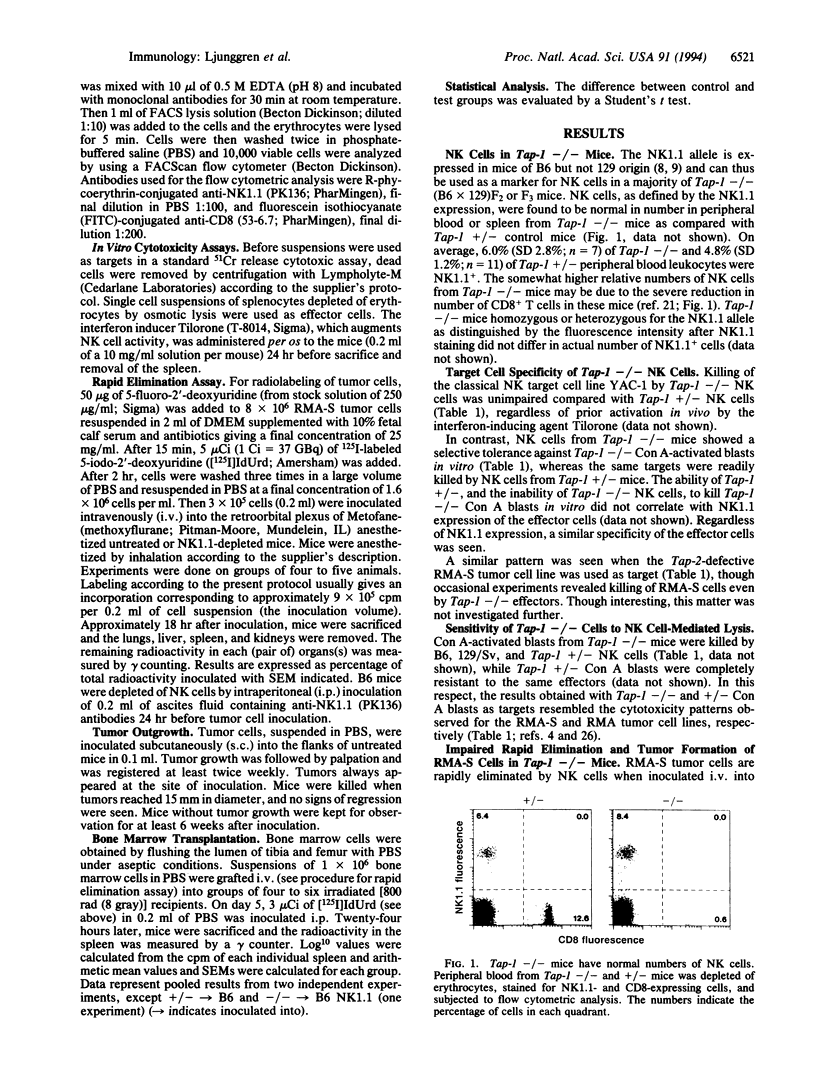
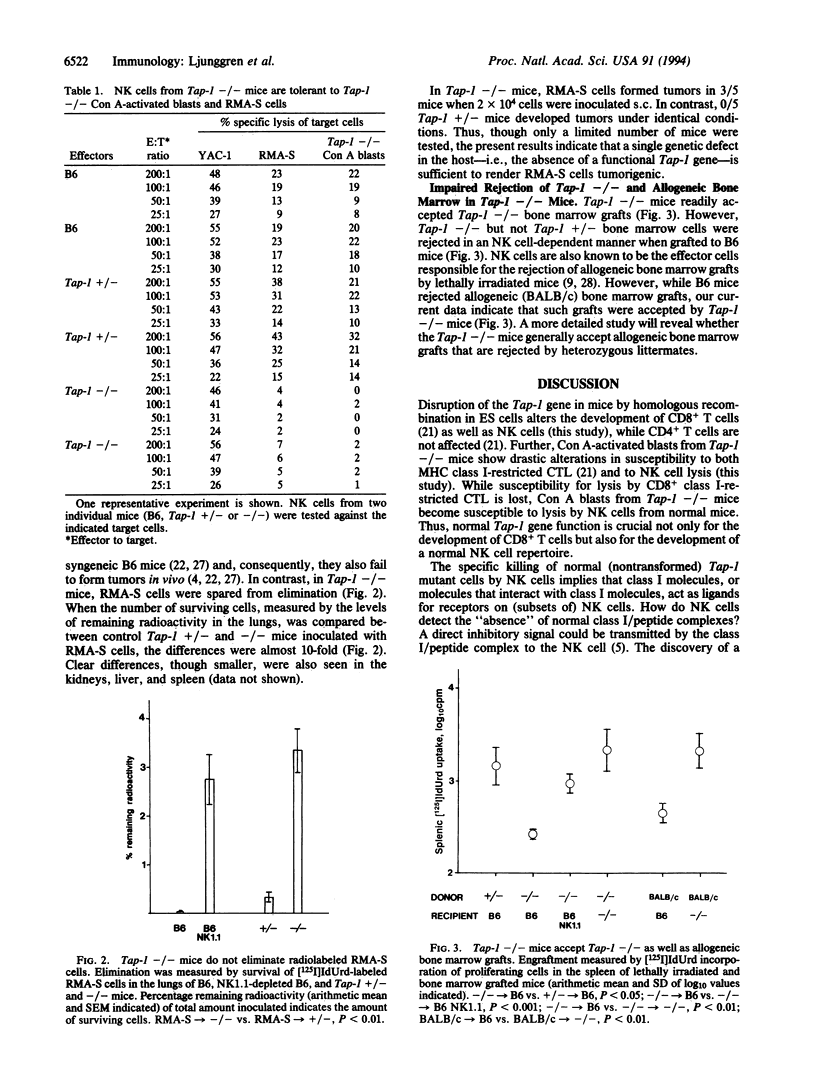
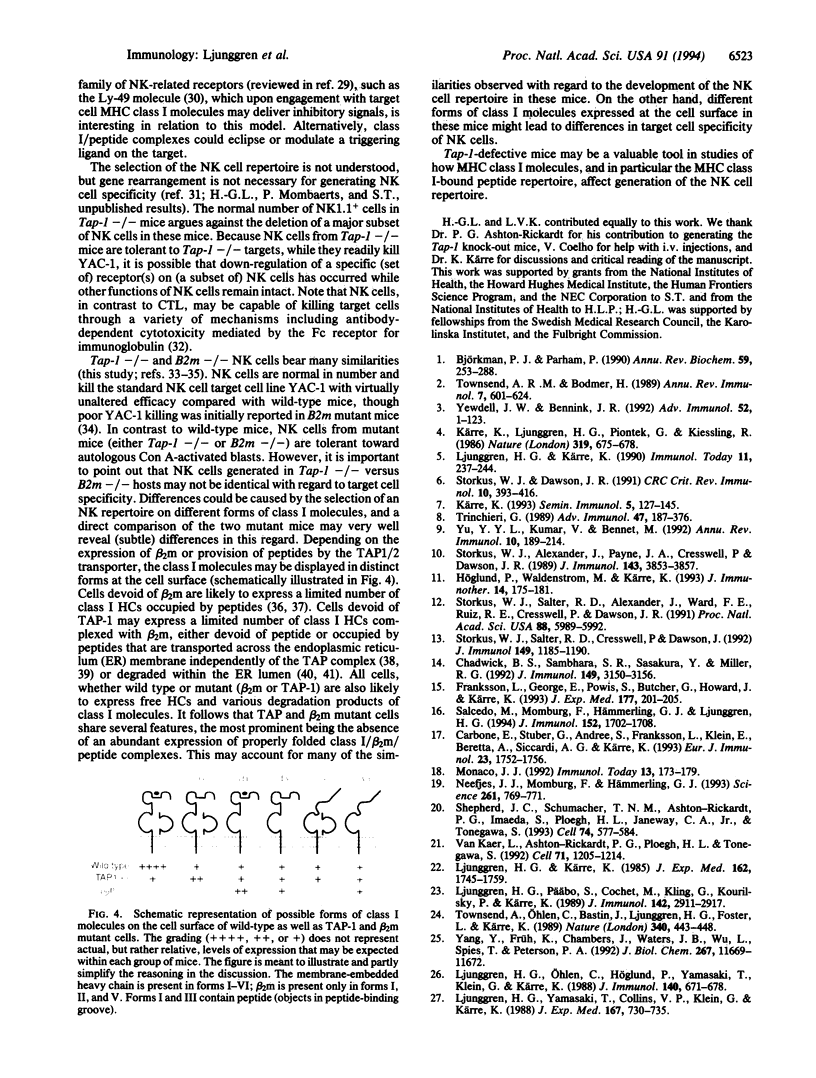
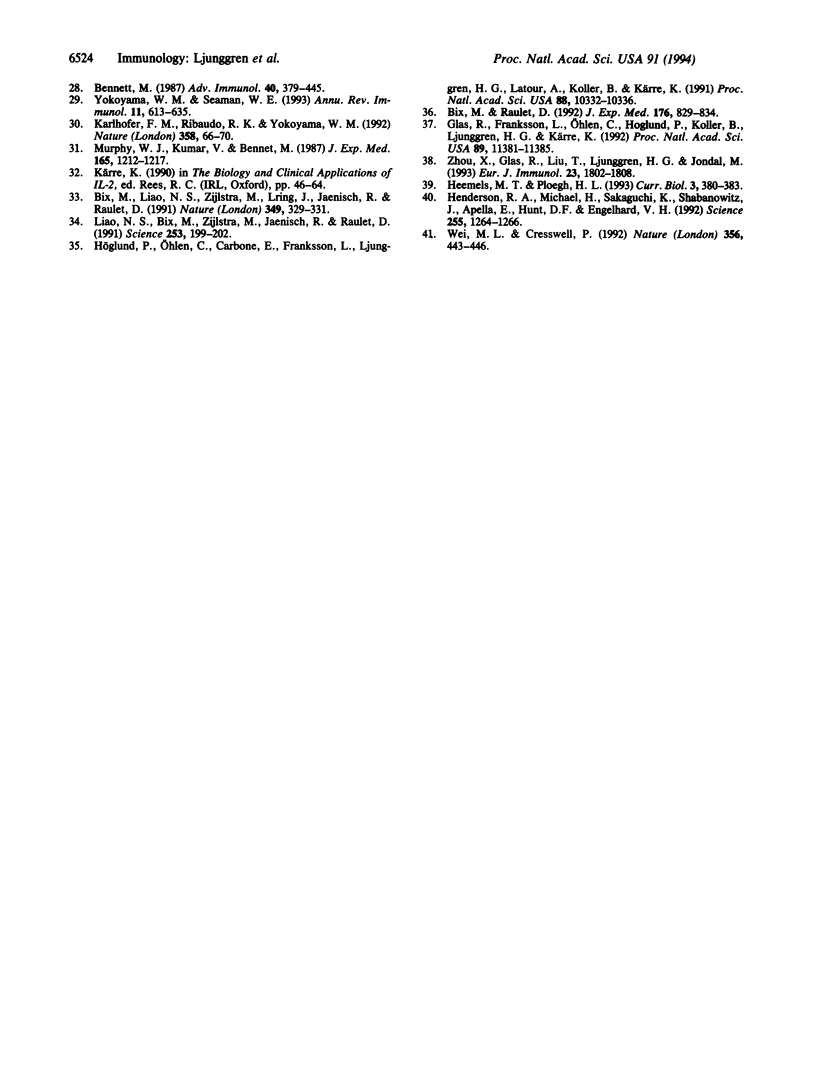
Images in this article
Selected References
These references are in PubMed. This may not be the complete list of references from this article.
- Bix M., Liao N. S., Zijlstra M., Loring J., Jaenisch R., Raulet D. Rejection of class I MHC-deficient haemopoietic cells by irradiated MHC-matched mice. Nature. 1991 Jan 24;349(6307):329–331. doi: 10.1038/349329a0. [DOI] [PubMed] [Google Scholar]
- Bix M., Raulet D. Functionally conformed free class I heavy chains exist on the surface of beta 2 microglobulin negative cells. J Exp Med. 1992 Sep 1;176(3):829–834. doi: 10.1084/jem.176.3.829. [DOI] [PMC free article] [PubMed] [Google Scholar]
- Bjorkman P. J., Parham P. Structure, function, and diversity of class I major histocompatibility complex molecules. Annu Rev Biochem. 1990;59:253–288. doi: 10.1146/annurev.bi.59.070190.001345. [DOI] [PubMed] [Google Scholar]
- Carbone E., Stuber G., Andrée S., Franksson L., Klein E., Beretta A., Siccardi A. G., Kärre K. Reduced expression of major histocompatibility complex class I free heavy chains and enhanced sensitivity to natural killer cells after incubation of human lymphoid lines with beta 2-microglobulin. Eur J Immunol. 1993 Aug;23(8):1752–1756. doi: 10.1002/eji.1830230803. [DOI] [PubMed] [Google Scholar]
- Chadwick B. S., Sambhara S. R., Sasakura Y., Miller R. G. Effect of class I MHC binding peptides on recognition by natural killer cells. J Immunol. 1992 Nov 15;149(10):3150–3156. [PubMed] [Google Scholar]
- Franksson L., George E., Powis S., Butcher G., Howard J., Kärre K. Tumorigenicity conferred to lymphoma mutant by major histocompatibility complex-encoded transporter gene. J Exp Med. 1993 Jan 1;177(1):201–205. doi: 10.1084/jem.177.1.201. [DOI] [PMC free article] [PubMed] [Google Scholar]
- Glas R., Franksson L., Ohlén C., Höglund P., Koller B., Ljunggren H. G., Kärre K. Major histocompatibility complex class I-specific and -restricted killing of beta 2-microglobulin-deficient cells by CD8+ cytotoxic T lymphocytes. Proc Natl Acad Sci U S A. 1992 Dec 1;89(23):11381–11385. doi: 10.1073/pnas.89.23.11381. [DOI] [PMC free article] [PubMed] [Google Scholar]
- Heemels M. T., Ploegh H. Antigen presentation: untapped peptides. Curr Biol. 1993 Jun 1;3(6):380–383. doi: 10.1016/0960-9822(93)90208-6. [DOI] [PubMed] [Google Scholar]
- Henderson R. A., Michel H., Sakaguchi K., Shabanowitz J., Appella E., Hunt D. F., Engelhard V. H. HLA-A2.1-associated peptides from a mutant cell line: a second pathway of antigen presentation. Science. 1992 Mar 6;255(5049):1264–1266. doi: 10.1126/science.1546329. [DOI] [PubMed] [Google Scholar]
- Höglund P., Ohlén C., Carbone E., Franksson L., Ljunggren H. G., Latour A., Koller B., Kärre K. Recognition of beta 2-microglobulin-negative (beta 2m-) T-cell blasts by natural killer cells from normal but not from beta 2m- mice: nonresponsiveness controlled by beta 2m- bone marrow in chimeric mice. Proc Natl Acad Sci U S A. 1991 Nov 15;88(22):10332–10336. doi: 10.1073/pnas.88.22.10332. [DOI] [PMC free article] [PubMed] [Google Scholar]
- Höglund P., Waldenström M., Kärre K. Role of major histocompatibility complex class I alpha 1/alpha 2 domain polymorphism and in vivo expression pattern in tumor resistance: studies with transgenic mice and lymphoma cell transfectants. J Immunother Emphasis Tumor Immunol. 1993 Oct;14(3):175–181. [PubMed] [Google Scholar]
- Karlhofer F. M., Ribaudo R. K., Yokoyama W. M. MHC class I alloantigen specificity of Ly-49+ IL-2-activated natural killer cells. Nature. 1992 Jul 2;358(6381):66–70. doi: 10.1038/358066a0. [DOI] [PubMed] [Google Scholar]
- Kärre K., Ljunggren H. G., Piontek G., Kiessling R. Selective rejection of H-2-deficient lymphoma variants suggests alternative immune defence strategy. Nature. 1986 Feb 20;319(6055):675–678. doi: 10.1038/319675a0. [DOI] [PubMed] [Google Scholar]
- Kärre K. Natural killer cells and the MHC class I pathway of peptide presentation. Semin Immunol. 1993 Apr;5(2):127–145. doi: 10.1006/smim.1993.1016. [DOI] [PubMed] [Google Scholar]
- Liao N. S., Bix M., Zijlstra M., Jaenisch R., Raulet D. MHC class I deficiency: susceptibility to natural killer (NK) cells and impaired NK activity. Science. 1991 Jul 12;253(5016):199–202. doi: 10.1126/science.1853205. [DOI] [PubMed] [Google Scholar]
- Ljunggren H. G., Kärre K. Host resistance directed selectively against H-2-deficient lymphoma variants. Analysis of the mechanism. J Exp Med. 1985 Dec 1;162(6):1745–1759. doi: 10.1084/jem.162.6.1745. [DOI] [PMC free article] [PubMed] [Google Scholar]
- Ljunggren H. G., Kärre K. In search of the 'missing self': MHC molecules and NK cell recognition. Immunol Today. 1990 Jul;11(7):237–244. doi: 10.1016/0167-5699(90)90097-s. [DOI] [PubMed] [Google Scholar]
- Ljunggren H. G., Ohlén C., Höglund P., Yamasaki T., Klein G., Kärre K. Afferent and efferent cellular interactions in natural resistance directed against MHC class I deficient tumor grafts. J Immunol. 1988 Jan 15;140(2):671–678. [PubMed] [Google Scholar]
- Ljunggren H. G., Päbo S., Cochet M., Kling G., Kourilsky P., Kärre K. Molecular analysis of H-2-deficient lymphoma lines. Distinct defects in biosynthesis and association of MHC class I heavy chains and beta 2-microglobulin observed in cells with increased sensitivity to NK cell lysis. J Immunol. 1989 Apr 15;142(8):2911–2917. [PubMed] [Google Scholar]
- Ljunggren H. G., Yamasaki T., Collins P., Klein G., Kärre K. Selective acceptance of MHC class I-deficient tumor grafts in the brain. J Exp Med. 1988 Feb 1;167(2):730–735. doi: 10.1084/jem.167.2.730. [DOI] [PMC free article] [PubMed] [Google Scholar]
- Martin P. J., Hansen J. A., Storb R., Thomas E. D. Human marrow transplantation: an immunological perspective. Adv Immunol. 1987;40:379–438. doi: 10.1016/s0065-2776(08)60243-6. [DOI] [PubMed] [Google Scholar]
- Monaco J. J. A molecular model of MHC class-I-restricted antigen processing. Immunol Today. 1992 May;13(5):173–179. doi: 10.1016/0167-5699(92)90122-N. [DOI] [PubMed] [Google Scholar]
- Murphy W. J., Kumar V., Bennett M. Rejection of bone marrow allografts by mice with severe combined immune deficiency (SCID). Evidence that natural killer cells can mediate the specificity of marrow graft rejection. J Exp Med. 1987 Apr 1;165(4):1212–1217. doi: 10.1084/jem.165.4.1212. [DOI] [PMC free article] [PubMed] [Google Scholar]
- Neefjes J. J., Momburg F., Hämmerling G. J. Selective and ATP-dependent translocation of peptides by the MHC-encoded transporter. Science. 1993 Aug 6;261(5122):769–771. doi: 10.1126/science.8342042. [DOI] [PubMed] [Google Scholar]
- Salcedo M., Momburg F., Hämmerling G. J., Ljunggren H. G. Resistance to natural killer cell lysis conferred by TAP1/2 genes in human antigen-processing mutant cells. J Immunol. 1994 Feb 15;152(4):1702–1708. [PubMed] [Google Scholar]
- Shepherd J. C., Schumacher T. N., Ashton-Rickardt P. G., Imaeda S., Ploegh H. L., Janeway C. A., Jr, Tonegawa S. TAP1-dependent peptide translocation in vitro is ATP dependent and peptide selective. Cell. 1993 Aug 13;74(3):577–584. doi: 10.1016/0092-8674(93)80058-m. [DOI] [PubMed] [Google Scholar]
- Storkus W. J., Alexander J., Payne J. A., Cresswell P., Dawson J. R. The alpha 1/alpha 2 domains of class I HLA molecules confer resistance to natural killing. J Immunol. 1989 Dec 1;143(11):3853–3857. [PubMed] [Google Scholar]
- Storkus W. J., Dawson J. R. Target structures involved in natural killing (NK): characteristics, distribution, and candidate molecules. Crit Rev Immunol. 1991;10(5):393–416. [PubMed] [Google Scholar]
- Storkus W. J., Salter R. D., Alexander J., Ward F. E., Ruiz R. E., Cresswell P., Dawson J. R. Class I-induced resistance to natural killing: identification of nonpermissive residues in HLA-A2. Proc Natl Acad Sci U S A. 1991 Jul 15;88(14):5989–5992. doi: 10.1073/pnas.88.14.5989. [DOI] [PMC free article] [PubMed] [Google Scholar]
- Storkus W. J., Salter R. D., Cresswell P., Dawson J. R. Peptide-induced modulation of target cell sensitivity to natural killing. J Immunol. 1992 Aug 15;149(4):1185–1190. [PubMed] [Google Scholar]
- Townsend A., Bodmer H. Antigen recognition by class I-restricted T lymphocytes. Annu Rev Immunol. 1989;7:601–624. doi: 10.1146/annurev.iy.07.040189.003125. [DOI] [PubMed] [Google Scholar]
- Townsend A., Ohlén C., Bastin J., Ljunggren H. G., Foster L., Kärre K. Association of class I major histocompatibility heavy and light chains induced by viral peptides. Nature. 1989 Aug 10;340(6233):443–448. doi: 10.1038/340443a0. [DOI] [PubMed] [Google Scholar]
- Trinchieri G. Biology of natural killer cells. Adv Immunol. 1989;47:187–376. doi: 10.1016/S0065-2776(08)60664-1. [DOI] [PMC free article] [PubMed] [Google Scholar]
- Van Kaer L., Ashton-Rickardt P. G., Ploegh H. L., Tonegawa S. TAP1 mutant mice are deficient in antigen presentation, surface class I molecules, and CD4-8+ T cells. Cell. 1992 Dec 24;71(7):1205–1214. doi: 10.1016/s0092-8674(05)80068-6. [DOI] [PubMed] [Google Scholar]
- Wei M. L., Cresswell P. HLA-A2 molecules in an antigen-processing mutant cell contain signal sequence-derived peptides. Nature. 1992 Apr 2;356(6368):443–446. doi: 10.1038/356443a0. [DOI] [PubMed] [Google Scholar]
- Yang Y., Früh K., Chambers J., Waters J. B., Wu L., Spies T., Peterson P. A. Major histocompatibility complex (MHC)-encoded HAM2 is necessary for antigenic peptide loading onto class I MHC molecules. J Biol Chem. 1992 Jun 15;267(17):11669–11672. [PubMed] [Google Scholar]
- Yewdell J. W., Bennink J. R. Cell biology of antigen processing and presentation to major histocompatibility complex class I molecule-restricted T lymphocytes. Adv Immunol. 1992;52:1–123. doi: 10.1016/s0065-2776(08)60875-5. [DOI] [PubMed] [Google Scholar]
- Yokoyama W. M., Seaman W. E. The Ly-49 and NKR-P1 gene families encoding lectin-like receptors on natural killer cells: the NK gene complex. Annu Rev Immunol. 1993;11:613–635. doi: 10.1146/annurev.iy.11.040193.003145. [DOI] [PubMed] [Google Scholar]
- Yu Y. Y., Kumar V., Bennett M. Murine natural killer cells and marrow graft rejection. Annu Rev Immunol. 1992;10:189–213. doi: 10.1146/annurev.iy.10.040192.001201. [DOI] [PubMed] [Google Scholar]
- Zhou X., Glas R., Liu T., Ljunggren H. G., Jondal M. Antigen processing mutant T2 cells present viral antigen restricted through H-2Kb. Eur J Immunol. 1993 Aug;23(8):1802–1808. doi: 10.1002/eji.1830230811. [DOI] [PubMed] [Google Scholar]



